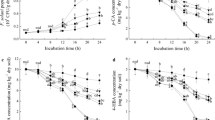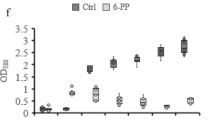Abstract
The prominent problem of continuous cropping obstacle has been frustrating the morel farming. To deepen the understanding on morel continuous cropping obstacle, the allelopathic effects of phenolic acid extracts from morel continuous cropping soils on growth and development of Morchella sextelata, M. eximia, M. importuna, pathogenic fungus Fusarium sp. and soil-dominant fungus Chaetomium sp. were investigated. These effects were expressed as response index (RI). Under actual content of phenolic acids (6.150 μg/g fresh mixed continuous cropping soil), the mycelial growth of all tested morel strains was inhibited (RI < 0), while the allelopathic effect of control phenolic acids (4.252 μg/g fresh mixed control soil) was between promotion and inhibition, which suggested that the phenolic acid extracts from morel continuous cropping soils may exhibit certain extent of autotoxicity for the existence of morel-specific allelochemicals. In addition, the aggravated pigmentation and reduced occurrence of sclerotium in three Morchella fungi at growth inhibitory concentrations of phenolic acids indicated the induction of morel strain aging. Meanwhile, most concentrations of phenolic acids showed stimulatory effects on sporulation of Fusarium sp. and Chaetomium sp. (RI > 0), manifesting the enrichment of soil-borne pathogenic fungi and dominance of certain fungal population in soil ecosystem. Collectively, the allelopathic effects of phenolic acid extracts play an instrumental role in morel continuous cropping obstacle. The study will be beneficial for healthy development of morel artificial cultivation.



Similar content being viewed by others
Data availability
The datasets generated during and/or analyzed during the current study are available from the corresponding author on reasonable request.
References
Baziramakenga R, Leroux GD, Simard RR (1995) Effects of benzoic and cinnamic acids on membranepermeability of soybean roots. J Chem Ecol 21:1271–85. https://doi.org/10.1007/BF02027561
Blum U, Shafer SR (1988) Microbial population and phenolic acids in soil. Soil Biol Biochem 20:793–800. https://doi.org/10.1016/0038-0717(88)90084-3
Blum U, Wentworth TR, Klein K, Worsham AD, King LD, Gerig TM, Lyu SW (1991) Phenolic acid content of soils from wheat-no till, wheat-conventional till, and fallow-conventional till soybean cropping systems. J Chem Ecol 17:1045–1068. https://doi.org/10.1007/bf01402933
Bu R, Xie J, Yu J, Liao W, Xiao X, Lv J, Wang C, Ye J, Calderón-Urrea A (2016) Autotoxicity in cucumber (Cucumis sativus L.) seedlings is alleviated by silicon through an increase in the activity of antioxidant enzymes and by mitigating lipid peroxidation. J Plant Biol 59:247–259. https://doi.org/10.1007/s12374-016-0526-1
Chen D, Wang M, Wang G, Zhou Y, Yang X, Li J, Zhang C, Dai K (2022) Functional organic fertilizers can alleviate tobacco (Nicotiana tabacum L.) continuous cropping obstacle via ameliorating soil physicochemical properties and bacterial community structure. Front Bioeng Biotechnol 10:1023693. https://doi.org/10.3389/fbioe.2022.1023693
Du XH, Zhao Q, Yang ZL (2015) A review on research advances, issues, and perspectives of morels. Mycology 6:78–85. https://doi.org/10.1080/21501203.2015.1016561
Fernandez C, Monnier Y (2009) Variations in allelochemical composition of leachates of different organs and maturity stages of Pinus halepensis. J Chem Ecol 35:970–979. https://doi.org/10.1007/s10886-009-9667-8
Guo M, Chen K, Wang G, Bian Y (2016) First report of stipe rot disease on Morchella importuna caused by Fusarium incarnatum–F. equiseti species complex in China. Plant Dis 100:2530. https://doi.org/10.1094/PDIS-05-16-0633-PDN
Han CM, Li CL, Ye SP, Wang H, Pan KW, Wu N, Wang YJ, Li W, Zhang L (2012) Autotoxic effects of aqueous extracts of ginger on growth of ginger seedlings and on antioxidant enzymes, membrane permeability and lipid peroxidation in leaves. Allelopathy J 30:259–270. https://doi.org/10.4025/actasciagron.v34i4.15061
Han Y, Yue Z, Zhang G, Gao J, Li P, Wang L, Li S, Zhao Z, Liu X, Wang L (2023) Fungal diversity and metabolic pathways in rhizosphere soil of Morchella esculenta with different planting years. Agric Sci 51(3):212–218. https://doi.org/10.15889/j.issn.1002-1302.2023.03.031
He C, Gao W, Yang J, Bi W, Zhang X, Zhao Y (2009) Identification of autotoxic compounds from fibrous roots of Panax quinquefolium L. Plant Soil 318:63–72. https://doi.org/10.1007/s11104-008-9817-8
He P, Liu W, Cai Y, He X (2015) Strain identification and phylogenetic analysis of cultivated and wild strains of Morchella belonging to Elata Clade in China. Journal of Zhengzhou University of Light Industry (natural Science) 30(3/4):26–29
He P, Li C, Cai Y, Zhang Y, Bian Y, Liu W (2018) First report of pileus rot disease on cultivated Morchella importuna caused by Diploöspora longispora in China. J Gen Plant Pathol 84:65–69. https://doi.org/10.1007/s10327-017-0754-3
He P, Yu M, Cai Y, Liu W, Wang W, Wang S, Li J (2019) Effect of aging on culture and cultivation of the culinary-medicinal mushrooms Morchella importuna and M. sextelata (Ascomycetes). Int J Med Mushrooms 21:1089–1098. https://doi.org/10.1615/intjmedmushrooms.2019032891
Inderjit SOD (2003) Ecophysiological aspects of allelopathy. Planta 217:529–539. https://doi.org/10.1007/s00425-003-1054-z
Inderjit (2005) Soil microorganisms: an important determinant of allelopathic activity. Plant Soil 274:227–236. https://doi.org/10.1007/s11104-004-0159-x
Jiang J, Zheng Q, Liu K, Ying G, Lü M (2021) Research progress of continuous cropping obstacle in Ganoderma lingzhi. Edible and Medicinal Mushrooms 29(2): 112–115. http://qikan.cqvip.com/Qikan/Article/Detail?id=7104383144
Kong C, Wang P, Gu Y, Wang M (2008) Fate and impact on microorganisms of rice allelochemicals in paddy soil. J Agric Food Chem 56:5043–5049. https://doi.org/10.1021/jf8004096
Li Z-H, Wang Q, Ruan X, Pan C-D, Jiang D-A (2010) Phenolics and plant allelopathy. Molecules 15:8933–8952. https://doi.org/10.3390/molecules15128933
Li M, Zhang L, Zhang Y, Zhu J, Ma H (2019) Review on the microbial biodegradation and metabolism of autotoxic phenolic acids. Asian J Ecotoxicol 14(3):72–78. https://doi.org/10.7524/AJE.1673-5897.20180808002
Li C, Chen G, Zhang J, Zhu P, Bai X, Hou Y, Zhang X (2021) The comprehensive changes in soil properties are continuous cropping obstacles associated with American ginseng (Panax quinquefolius) cultivation. Sci Rep 11:5068. https://doi.org/10.1038/s41598-021-84436-x
Liu W, Zhang Y, He P (2017) Biology and Cultivation of Morchella Mushrooms. Jilin Science and Technology Press, Changchun, China
Liu Q, Ma H, Zhang Y, Dong C (2018) Artificial cultivation of true morels: current state, issues and perspectives. Crit Rev Biotechnol 38:259–271. https://doi.org/10.1080/07388551.2017.1333082
Liu W-Y, Guo H-B, Bi K-X, Sibirina LA, Qi X-J, Yu X-D (2022) Determining why continuous cropping reduces the production of the morel Morchella sextelata. Front Microbiol 13:903983. https://doi.org/10.3389/fmicb.2022.903983
Ma Z, Guan Z, Liu Q, Hu Y, Liu L, Wang B, Huang L, Li H, Yang Y, Han M, Gao Z, Saleem M (2023) Obstacles in continuous cropping: mechanisms and control measures. Adv Agron 179:205–256. https://doi.org/10.1016/bs.agron.2023.01.004
Mu Y, Yuan D, Lan Y, Tian W, Zhang J (2016) Wang C (2016) Effects of tea planting age on soil pH value, contents of organic matter and phenolic acids. Soil Fertilizer Sci China 4:44–48. https://doi.org/10.11838/sfsc.20160407
Rice EL (1984) Allelopathy, 2nd edn. Academic Press, New York
Sambyal K, Singh RV (2021) A comprehensive review on Morchella importuna: cultivation aspects, phytochemistry, and other significant applications. Folia Microbiol 66:147–157. https://doi.org/10.1007/s12223-020-00849-7
Shashwati G, Ashish S (2007) Microbial transformation of ferulic acid to vanillic acid by Streptomyces sannanensis MTCC6637. J Ind Microbiol Biot 34:131–138. https://doi.org/10.1007/s10295-006-0177-1
Shi X, Liu D, He X, Liu W, Yu F (2022) Epidemic identification of fungal diseases in Morchella cultivation across China. J Fungi 8:1107. https://doi.org/10.3390/jof8101107
Singh HP, Batish DR, Kohli RK (1999) Autotoxicity: concept, organisms, and ecological significance. Crit Rev Plant Sci 18:757–772. https://doi.org/10.1080/07352689991309478
Tan H, Liu T, Yu Y, Tang J, Jiang L, Martin FM, Peng W (2021) Morel production related to soil microbial diversity and evenness. Microbiol Spectr 9:e0022921. https://doi.org/10.1128/Spectrum.00229-21
Tietel Z, Masaphy S (2017) True morels (Morchella)—nutritional and phytochemical composition, health benefits and flavor: a review. Crit Rev Food Sci Nutr 58:1888–1901. https://doi.org/10.1080/10408398.2017.1285269
Wang Y, Li C, Wang Q, Wang H, Duan B, Zhang G (2016) Environmental behaviors of phenolic acids dominated their rhizodeposition in boreal poplar plantation forest soils. J Soils Sediments 16:1858–1870. https://doi.org/10.1007/s11368-016-1375-8
Wiliamson GB (1988) Bioassays for allelopathy measuring treatment responses with independent control. J Chem Ecol 14:181–187. https://doi.org/10.1007/BF01022540
Wu E, Xu N, Wen M (2000) The measurement of total phenolic acids in soil by phosphomolybdic-phosphotungstic acid phenol reagent colorimetry. Environ Chem 19:67–72
Xie Z, Ma Q, Peng W, Wang Z, Wu P, Sun Y (2021) Research progress on continuous cropping obstacle and green control of strawberry. E3S Web Conf 251:02044. https://doi.org/10.1051/e3sconf/202125102044
Zhang X, Pan Z, Zhou X, Ni W (2007) Autotoxicity and continuous cropping obstacles: a review. Chin J Soil Sci 38:781–784. https://doi.org/10.19336/j.cnki.trtb.2007.04.033.html
Zhang Z, Zhang Z, Han X, Wu J, Zhang L, Wang J, Wang-Pruski G (2020) Specific response mechanism to autotoxicity in melon (Cucumis melo L.) root revealed by physiological analyses combined with transcriptome profiling. Ecotox Environ Safe 200:110779. https://doi.org/10.1016/j.ecoenv.2020.110779
Zhang X, Shi S, Li X, Li C, Zhang C-M, Yun A, Kang W-J, Yin G-L (2021) Effects of autotoxicity on alfalfa (Medicago sativa): seed germination, oxidative damage and lipid peroxidation of seedlings. Agronomy 11(6):1027. https://doi.org/10.3390/agronomy11061027
Zhao F, Zhang Y, Li Z, Shi J, Zhang G, Zhang H, Yang L (2020) Vermicompost improves microbial functions of soil with continuous tomato cropping in a greenhouse. J Soils Sediments 20:380–391. https://doi.org/10.1007/s11368-019-02362-y
Funding
This work was supported by Project of Scientific and Technological Envoys of Henan Province [YuKe (2023) No. 68] and the Basic Research Project of Yunnan Provincial Department of Science and Technology (202101AT070541).
Author information
Authors and Affiliations
Contributions
All the authors contributed to the study conception and design. WL obtained the research funding. Material preparation, data collection and analysis were performed by QY, ZC, WZ and XC. The first draft of the manuscript was written by PH, and all the authors commented on previous versions of the manuscript. All the authors read and approved the final manuscript.
Corresponding authors
Ethics declarations
Conflict of interest
The authors have no relevant financial or non-financial interests to disclose.
Consent to participate
Not applicable.
Consent to publish
Not applicable.
Ethical approval
Not applicable.
Additional information
Communicated by Yusuf Akhter.
Publisher's Note
Springer Nature remains neutral with regard to jurisdictional claims in published maps and institutional affiliations.
Supplementary Information
Below is the link to the electronic supplementary material.
Rights and permissions
Springer Nature or its licensor (e.g. a society or other partner) holds exclusive rights to this article under a publishing agreement with the author(s) or other rightsholder(s); author self-archiving of the accepted manuscript version of this article is solely governed by the terms of such publishing agreement and applicable law.
About this article
Cite this article
Yin, Q., Chen, Z., He, P. et al. Allelopathic effects of phenolic acid extracts on Morchella mushrooms, pathogenic fungus, and soil-dominant fungus uncover the mechanism of morel continuous cropping obstacle. Arch Microbiol 206, 55 (2024). https://doi.org/10.1007/s00203-023-03790-8
Received:
Revised:
Accepted:
Published:
DOI: https://doi.org/10.1007/s00203-023-03790-8




